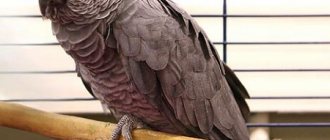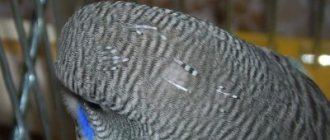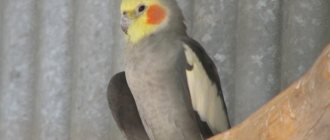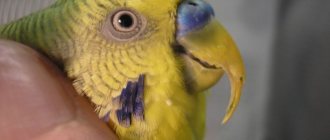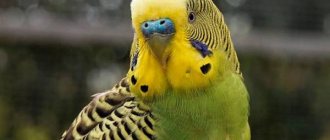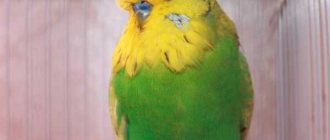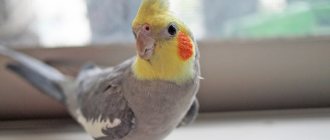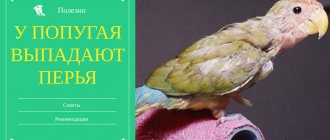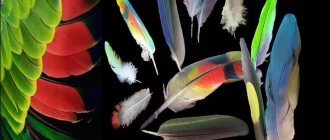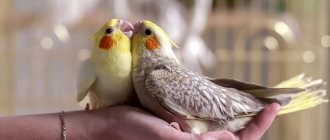Shedding in cockatiels is a common occurrence that occurs in all parrots at one time or another. However, for inexperienced owners it often causes fear and concern for the health of their pet. In most cases, cockatiels' feathers fall out due to natural reasons, but it happens that this process occurs due to illness. Let's talk about when cockatiel parrots begin to molt, how you can help your pet during this difficult period for him, about the natural and pathological reasons for the change in plumage.
Physiological molting
Immediately after birth, cockatiels are covered with soft yellowish fluff. After a few weeks, the chicks' plumage changes to that of an adult. Then the fluff falls out, and colorful feathers appear in its place. This process is called juvenile molting.
All subsequent plumage changes are called periodic. These periods are associated with the time of year, phases of the nesting cycle and mating season. Also, the replacement of plumage is affected by age, nutrition, level of humidity, light and temperature in the room where the cockatiel’s cage is located.
Normally, during the first molt, large feathers fall out from different parts of the body in a certain order, and down falls out chaotically.
Also, molting in a cockatiel is accompanied by the appearance of special formations on the skin and the release of secretions; the bird often itches during this period.
Juvenile
This type of molting occurs only in chicks that are completely covered with soft down. After a few months, the fluff is replaced by a stronger and harder feather. The new plumage provides more protection and allows the bird to fly.
Cockatiels begin molting at the age of 4–6 months.
The exact time when a parrot begins to change its plumage depends on care and maintenance, as well as nutrition. But in any case, the first molt should begin before six months of age. If this does not happen, the bird is most likely sick.
Important! During the first moult, new plumage appears closer to the age of one year. Its completion indicates that the cockatiel can find a mate and have offspring.
Periodic
Juvenile plumage changes are followed by periodic plumage changes. The time at which the cockatiel will moult depends on the time of year, mating season and nesting phase.
If a feathered pet lives alone, then it will change its plumage 1-2 times a year. Typically, molting occurs between September and December. The change of feather cover takes about 30 days.
If a pair of cockatiels lives in a cage, then their feathers will fall out during the mating season, or more precisely, after mating, and also when the female begins to lay eggs.
Interesting! During molting, cockatiels become restless and behave aggressively. The fact is that feathers that break through the skin cause discomfort, irritation and itching.
Some birds become passive and drowsy when molting. They try to devote more time to sleep, but they are unable to rest properly due to discomfort.
Causes of receding hairline
Baldness under the wings can be caused by various reasons. The main ones include:
- ecological environment;
- psychological state of the bird;
- hormonal disbalance;
- fungal and parasitic infection;
- avitaminosis.
Now let's discuss each of them in more detail.
- Let's start with environmental problems. Among them are too dry air in the apartment, improper lighting and poor-quality food, which provoked an allergic reaction. Very dry air occurs in those rooms in which heaters operate, so to make the bird’s life easier, you should install humidifiers, or at least put a wet rag on the radiator. If you see bald spots under the wings of a parrot, then do not forget to also check whether this is due to a fluorescent lamp, and a flickering lamp can generally cause stress in the bird. And, of course, feed the bird only high-quality and proven food.
- Psychological condition. These birds are very sensitive and any changes in their lives can result in heavy loss of feathers. So the condition of the parrot will be negatively affected by: moving, changing the owner, repairs and domestic quarrels, as well as the appearance of another pet in the apartment.
- Hormonal imbalance usually occurs in pets that suffer from loneliness. They often begin to pluck themselves. To eliminate this problem, you should buy him a pair or use special medications.
- Fungal and parasitic infections can occur in any pet if you do not follow good hygiene. But with such a lesion, not only bald spots are observed under the wings of the parrot, but also ulcers, growths, and peeling skin appear. A fungal infection can only be detected by taking tests, but you will see mites yourself. To do this, it is worth examining the tips of the feathers; if they are in the blood, then the parasites are definitely attacking the bird. In addition, at night you should put a piece of white paper on the bottom of the cage, and in the morning you can see ticks on it.
- Avitaminosis. If a bird is given monotonous food that lacks various beneficial vitamins, then it is definitely at risk of baldness.
Features of changing plumage
Physiological molting does not disrupt the lifestyle of cockatiels. Therefore, the change of plumage takes place according to this plan:
- The loss of tail and flight feathers occurs gradually, in a certain order. Therefore, the parrot can fly even during molting. After all, it is with the help of these feathers that the bird rises into the air. It will continue to fly, but its speed and altitude will temporarily decrease slightly. After the end of molting, all indicators will be restored.
- Cockatiels' tail feathers will fall out from the edges towards the center. The feathering on the wings changes gradually, 2 pieces fall out every week.
- The down covering falls out in a chaotic manner. If a bird spends a lot of time in a cage, it can lose almost 50% of its fluff.
- On the bare areas of the cockatiel's body, stump tubes remain, from under which new feathers appear. In addition to the feather covering, you can see light powder in the cage. This is the secret that makes a parrot's plumage stand out.
During molting, birds become restless and scratch a lot.
How to help your pet
If you notice your pet's feathers falling out or scratching, you should follow a number of rules:
- It is important to contact a veterinarian as soon as possible to determine why your pet is itching and plucking feathers.
- In order to notice the pathology in time and prevent the development of the disease, including tick-borne infection, it is necessary to regularly examine the pet and monitor its behavior.
- When there are several pets in a cage, if one of them gets sick, you should put him away, and watch the rest more closely.
- During therapy, nutrition should be varied.
- During illness, your pet needs to be given enough attention.
- It is necessary to clean the cage regularly.
- You can discourage feather plucking by using a bitter spray, such as Beafar Spray.
- You can use a special collar, but you need to remember that by plucking the feathers, the bird puts them in order. The collar will interfere with her exercise, while the pathology can progress and as soon as the collar is removed, the bird will begin to pluck itself.
If a parrot loses feathers, it must be shown to a specialist who will make a diagnosis and prescribe the necessary therapy.
Caring for parrots during the molting period
Molting requires a lot of energy, and the reserves of nutrients in the body are depleted. A varied diet, as well as suitable living conditions, will help offset the costs.
The cockatiel's menu should be supplemented with products that contain large amounts of keratin. They will help the parrot survive molting faster and easier without exhausting the body.
Special requirements are put forward for the conditions of keeping cockatiels. For example, adult birds can be allowed to fly around the room, but chicks cannot. It is better to bathe them in the shower. It is also important to control the humidity level and temperature in the room where the bird cage is located.
Diet
During the molting period, your cockatiel's diet should include vegetables, fruits, herbs, protein foods, and mineral supplements.
The bird should be fed carrots, pumpkin, zucchini, and cabbage.
The diet must be replenished with juicy greens:
- spinach;
- sprouted oats, wheat;
- fresh grass;
- carrot and beet tops;
- branches and stems of fruit trees.
The cockatiel's body needs beneficial substances found in fruits and berries. The birds are fed apples, bananas, and grapes. They are also given cherries, sweet cherries, raspberries, and strawberries.
Cottage cheese will help saturate the body with proteins; only parrots need to choose a low-fat fermented milk product. Also, the bird’s diet during the molting period is supplemented with boiled chicken eggs.
Important! Vegetables and fruits are used as top dressing. Do not overfeed the bird. A mixed salad is made from these products.
The menu is supplemented with mineral supplements:
- crushed eggshells;
- mineral stone or sand;
- feed limestone;
- crushed calcium gluconate (1 tablet per day).
During molting, the cockatiel can be treated to mealworm larvae, bloodworms, and grasshoppers.
To support the bird’s body, a veterinarian can prescribe vitamins:
- Vitacraft;
- Beaphar Mauser Tropfen;
- Vita-Sol Multi Vitamins;
- Rio grain mixture.
Chamomile infusion will help relieve itching and irritation on the skin during shedding. For this, 1 tbsp. l. dry raw materials, pour 220 ml of boiling water and cool. Warm liquid is used to wipe bald areas on the cockatiel's skin.
Conditions of detention
Molting changes the behavior of parrots, so owners need to follow the following rules for keeping them:
- Adult birds that have already experienced a molt are allowed to fly indoors. Such a “walk” will help them take their mind off discomfort and speed up the loss of old feathers. On the contrary, it is not recommended to release chicks during the first molt. Discomfort will distract them, so there is a high risk that they will not cope with the flight, fall and get injured.
- Water treatments will help speed up shedding. Cockatiels need to be bathed in the shower to relieve itching. A container of water can be placed in a cage, but then the birds may turn it over.
- It is important to control the humidity level (60–70%) and temperature (20–25°C) in the cage. After all, there will be bare areas on the cockatiel’s body, due to which the bird will freeze or overheat.
If these rules are violated, molting will last longer. In addition, the risk of exhaustion of the feathered pet will increase.
Pathological shedding
Sometimes a parrot loses its feathers due to various disorders in the body or diseases. Veterinarians distinguish the following causes of feather loss in cockatiels:
- microclimate changes;
- frequent or excessive stress;
- poor nutrition;
- health problems.
If there is a lack of certain minerals or vitamins, the body does not produce the required amount of keratin, without which new feathers cannot grow quickly. Then the parrot remains with bald patches longer. To solve the problem, it is enough to adjust the diet.
Pathological shedding may be associated with more serious problems:
- oncological formations;
- hormonal imbalance;
- impaired absorption of vitamins A and D.
These diseases in cockatiels prolong the molting period. Then more bald patches appear on the body; upon closer examination, it is noticeable that the feather tubes are not open.
The parrot looks unkempt, is restless, aggressive or lethargic, constantly itches, and tries to pluck feathers.
Prolonged or untimely shedding requires veterinary intervention. A specialist will help determine its cause.
Parasites and infections
One of the reasons for feather loss in cockatiels is infection with ectoparasites (external). These include ticks, fluff eaters, fleas, and bedbugs. A molting bird experiences constant severe itching, which causes it to scratch areas of its body and pluck feathers.
Fleas can be detected by visual inspection. If parasites are not visible, but traces of their vital activity are present, then most likely the bird is infected with mites.
Interesting! You can check for the presence of microscopic parasites using a white sheet of paper. It is placed on the floor of the cage and left for a day. If dark dots appear on the surface, this indicates that the bird is infected with ectoparasites.
The pathogen can only be identified through laboratory tests. For treatment, medications are used in the form of ointments or suspensions prescribed by a veterinarian.
Stress
Cockatiels lose feathers due to stressful situations:
- moving or changing the location of the cage;
- deterioration of living conditions;
- change in feed;
- unbalanced diet;
- loud or harsh sounds;
- too bright lighting;
- the appearance of new pets or people in the house;
- lack of communication with a person;
- aggressive behavior of the owner.
All these factors can lead to pathological shedding. To stop it, you need to eliminate the irritant.
If a cockatiel's tail feathers suddenly begin to fall out, but the rest of the body is normal, then stress may be the cause. The parrot becomes restless, apathetic or aggressive. He doesn't want to play with his owner and refuses his favorite treats.
It is important to eliminate the irritant, normalize nutrition, and provide a calm environment. It is also recommended to heat the cage with a lamp, which is installed at a distance of 50 cm.
Cyst
Pathological molting (local) can occur due to a follicular cyst. This formation occurs when feathers that are too soft cannot pierce the skin and curl up into a ball. Later this leads to inflammation of the follicle and the development of a purulent process.
In the area where the feather has not sprouted, dry crusts appear. And a rounded lump protrudes through the skin.
The only way to get rid of a cyst is through surgery. The pathological formation is cut from above, the feather is removed, and the wound is treated with antiseptics.
French molt
This is a serious disease that results in inability to fly or even death. Unfortunately, the pathology is still almost unstudied. Scientists suggest that it occurs against the background of a viral disease, due to a severe weakening of the female’s body or a deficiency of proteins in the body of parents and young animals.
Symptoms of French molt appear in chicks. They lose large feathers before or after their first plumage change. Then they do not grow back or are formed with defects. Then the cockatiel loses the ability to fly. In this case, the psyche of the bird does not suffer.
Important! French molt is incurable as its exact cause has not yet been identified.
Signs of cockatiel disease and their symptoms
Any changes in the parrot's behavior should alert you. A sick bird is very different in behavior and appearance from a healthy one.
1. Watch the parrot. A sick bird will be lethargic, indifferent, and will not react to what is happening. As a rule, such a bird sits ruffled, with half-closed eyes, and has no appetite. 2. Inspect the plumage. The feathers should be shiny, smooth, and fit well together. If the feathers are damaged and break easily, then your bird is most likely suffering from parasite infestation or feather disease. 3. Listen to your pet's breathing. Excessively heavy or rapid breathing may indicate illness in your cockatiel. 4. Inspect the beak, it should be shiny, without tumors or abscesses. The beak must be the appropriate color.
5. Pay attention to the cleanliness of the feathers. Dirty feathers near the cloaca indicate digestive problems. If the feathers on the breast are dirty, this may be a sign of an infectious disease of the goiter, which is accompanied by vomiting. 6. Gently feel the muscles on the bird's breast. She may be experiencing muscle atrophy. This happens with poor nutrition. Then the breast bone can be easily felt or even visible without palpation. 7. The parrot's eyes should be clean and shiny. Various types of discharge may indicate the presence of a disease. 8. Carefully remove the feathers and inspect the ear openings. They should not show signs of inflammation, and they should not contain foreign bodies.
Sometimes various diseases of Corella parrots have similar symptoms, and in order for the treatment to be correct and timely, it is better to contact a veterinarian for clarification. Moreover, some cockatiel diseases can only be diagnosed using certain procedures.
